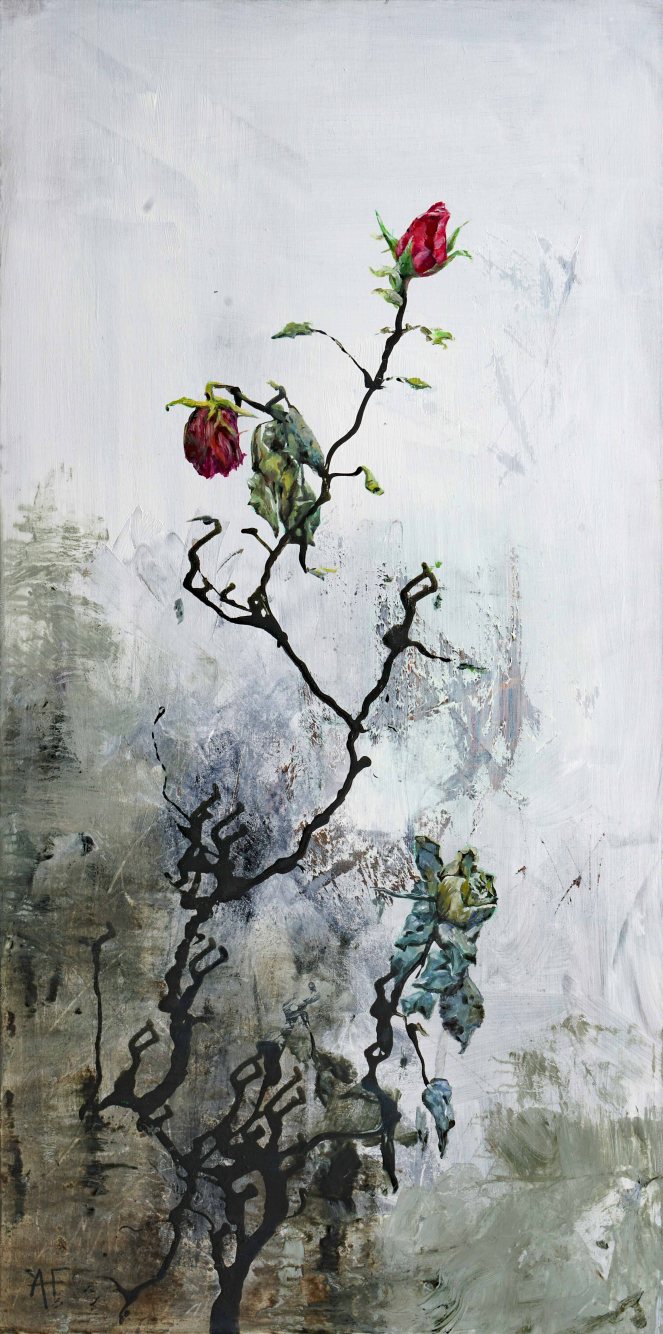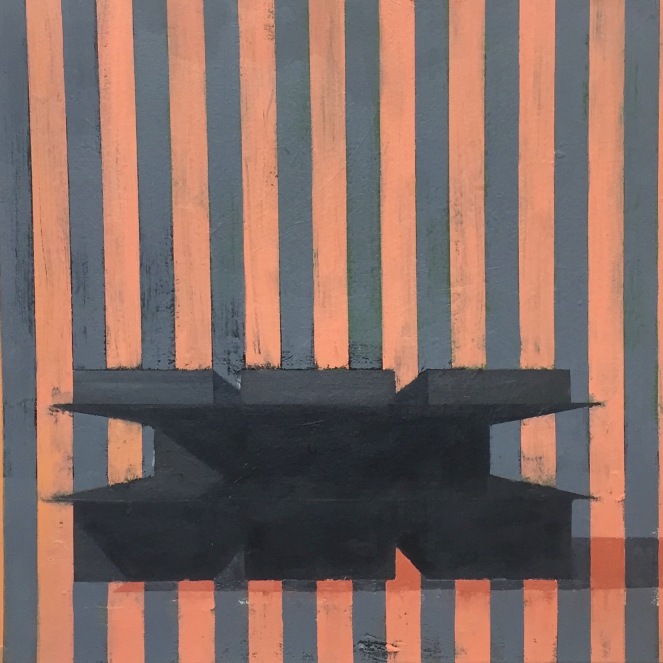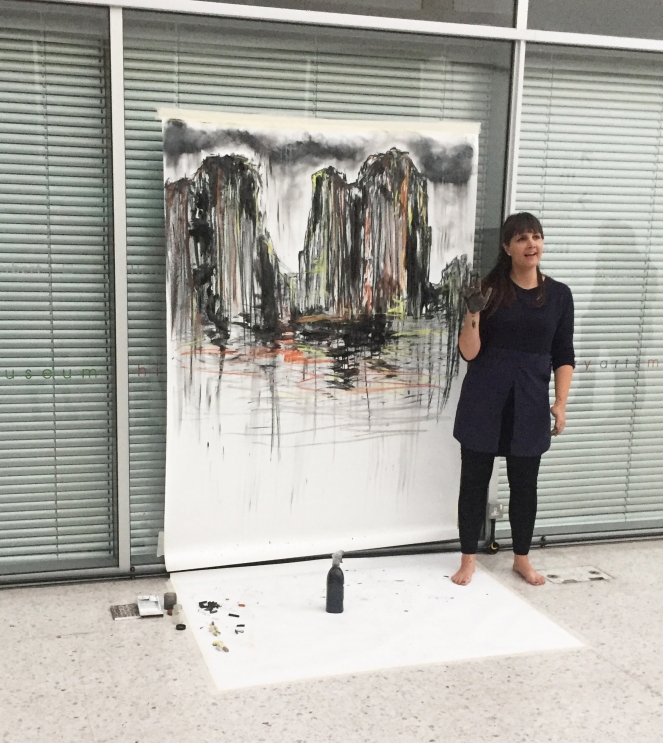
As the inaugural Coventry Biennial of Contemporary Art draws to a close, we have reflected on the excitement that such an ambitious, large-scale visual arts event brought to the city. The festival’s vast programme consisted of 13 exhibitions and over 60 events, featuring a diverse selection of local, national and international artists. The Biennial launch night alone saw over 1,000 attendees! One thing is for certain – the event sure drew in the crowds.
“The Future” was the key theme running through the festival, and made title for the Biennial’s central exhibition at the former Coventry Evening Telegraph building. What an incredible and fitting venue this made. This vast maze holds abandoned offices, eerie-dimly-lit corridors, and huge industrial print spaces, still hosting machinery from the now out-dated print industry. It provided such an interesting juxtaposition of the old vs. the new, where the now redundant, media-production was replaced by so many contemporary pieces of artwork, reacting to “The Future” theme, and created in response to the building itself.
You were free to roam the whole building, and experience each piece of work in it’s setting, a vast majority of which were site-specific pieces. In experiencing the sheer scale of such an immense showcase, we soon began to understand the hard work and vision that the Director Ryan Hughes, and his team, had put into curating such a vast and diverse exhibition.
Mira Calix’s installation dominated the former press hall, an incredible audio/visual immersive experience “By being in two places at once”. Contrasting sounds echoed through the hall, while a twisting network of wires leading to different screens represented the idea of the way in which we occupy both our physical and non-physical environments.

Martin Green’s installation “How do I know if I’m addicted”, and live-curation the following week, presented a fascinating project created from years of collecting categorised found objects. He displayed a huge array of double-sided paintings, each positioned like miniature sculptures, balanced upon found laughing gas canisters. They formed a series organised around the words “acquiesce” and “dissent” – reflecting the many “distractions” in which he says he is defined by.

Artist collaboration Georgiou/Tolley’s “Magician Walks into the Laboratory” delves back into the cold war era, a time of global anxiety. This haunting, engaging audio/visual installation was created using CIA transcripts from ‘remote viewing’ sessions, and was voiced by the famous actor, Jack Klaff, acting as the fictional CIA agent. The project reflected issues surrounding mass surveillance, data gathering, biased media and even pseudo time-travel. From speaking to the artists prior to the event, we also felt gained an insight into concerns for the future, as technology continues developing at it’s alarming rate. Some really mind-blowing issues were raised.

There was a degree of sardonic humour in some of the work, including Daniel Salisbury’s “Zen Garden Litter Tray”, incorporating a Chinese “Lucky Cat” statue amongst a sand-tray of discarded human litter – fag-butts, empty cans and food packaging.

Joe Fletchor Orr’s neon light “Turnt Down”…

and Kurt Hickson’s “Shit Neon”.

Local photographer Natalie Seymour (who we have interviewed) exhibited a series of photographic collages aiming to capture the essence of the Coventry Telegraph building prior to its change of use and modernisation.

Birmingham artist Paul Newman displayed a series of paintings in which he incorporated imagined, and sometime futuristic landscapes exploring a contradictory push-pull of pictorial space and abstraction.

Local artist John Yeadon paid homage to the oldest working digital computer in the world, with his 2017 version of his painting “WITCH” – he initially created a painting of this computer back in 1983, as a satire on modernism, a parody on “computer art”. The re-invention of this painting became a homage to the history of this mechanical national treasure, and fitted perfectly in it’s setting in the exhibition space, alongside the building’s original modular electronics.
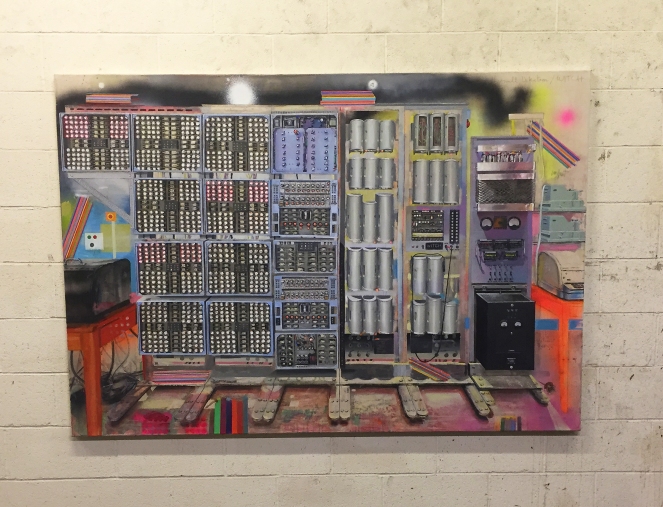
Other exciting site-specific installation works, which pleasingly occupied their exhibition space included:
This untitled mixed media installation by James Lomax,

Katie Holden’s installation created with concrete and found metal supports,

and Matt Gale’s “Fatball” piece which trickled out to it surrounding outside the building and could be viewed looking through the windows.

Thirty-five different artists exhibited in total, so we’ve barely scratched the surface here, but the team behind the Biennial have put together a great Instagram Tour looking at each piece of art on display.
Other impressive exhibitions that we visited during the Biennial included “Laws of Motion in a Cartoon Landscape” by Andy Holden at The Box, FarGo Village: An hour long lecture delivered by the artist’s avatar guided through an animated landscape populated by iconic cartoon characters. Laws of physics were studied and questioned while he investigated how retro cartoons gave us a “prophetic glimpse’ into the world in which we now live.

In contrast to this, London-based artist, Fiona Grady had a wonderfully unique site-specific display at the Tin Music and Arts, “Light Shifts”. The work consisted of hand-cut vinyl window stickers made up from geometric shapes, replicating the grid-like window shutters found in this lovely exhibition space. Throughout the day they brighten and glow, when viewed from both the building’s interior and exterior, altering with the daylight and weather changes. The interior walls of the exhibition space map how this light is projected on the walls throughout the day.

Re-Tale by artist collaboration Ha, was another project that took place throughout the Biennial, occupying The Glass Box gallery as it’s exhibition space. To view, it appeared stark and barren, the sorrowful sight of a showroom ready to close, with simple carrier bags lined up along the walls. The project is in fact part of a data-gathering exercise, which the people of Coventry were encouraged to take part in. We interviewed the artists prior to the Biennial to gain further insight. Read more here.
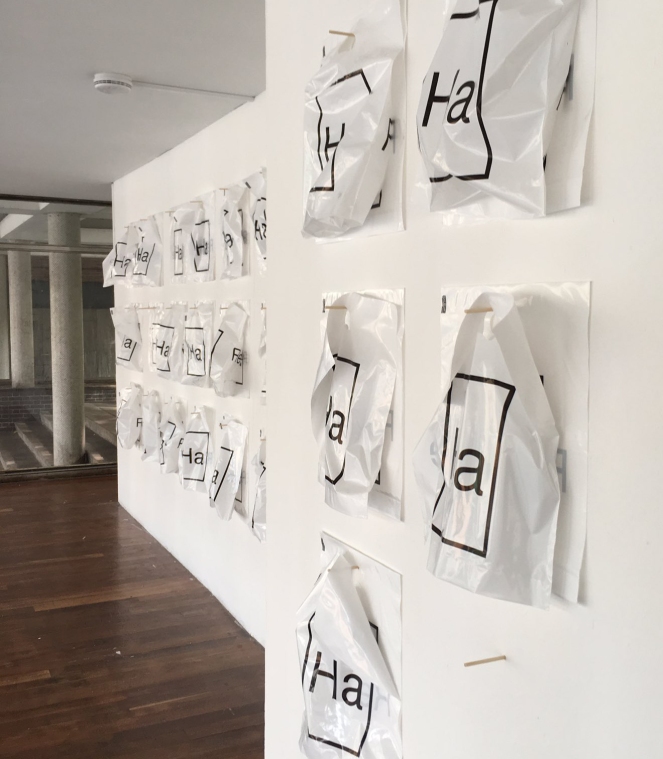
The Class Room gallery at Holyhead Studios hosted another remarkable exhibition by the artist James Faure Walker – a renowned international artist now based in London. Since the 1980’s his work integrated computer graphics with oil paint and watercolour. Using exuberant colours, and graphically influenced abstract imagery, this provided a unique and interesting collection in this wonderful gallery space.

The Coventry Biennial intertwined with parts of the Scratch the Surface festival, so some exhibitions were covered by both programmes, such as Wen Wu’s Literary Paintings at CCCA Fargo Village, the END//BEGIN – Dialogue at City Arcadia, and the screening of the first ever FilmZine – you can read more about these exhibitions here.

This is just a small section of the festival’s sixty events that we thoroughly enjoyed attending. There were parties, performances, tours, workshops, lectures, artist supermarkets, yoga, plus a host of family workshops inspired by the artwork of some the Biennial’s artists.
Before we wind up we’d like to say a massive well done to Director Ryan Hughes and his team. Thank you to all involved in executing an event of such magnitude – you drew in crowds, not just locally, but from across the country. This is just what was needed for a city bidding to be the City of Culture 2021, and will keep us talking for weeks to come.





